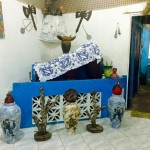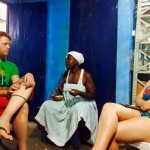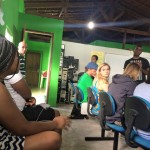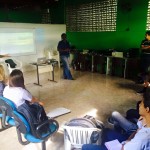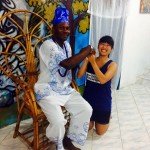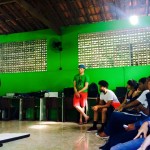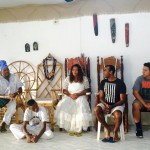June 19, 2015
By: Paul-Anne Robb
At 9 a.m., the group left the hostel and made our way to the bus stop. Our destination was the Afro-Brazilian Museum and the Museum of Archeology and Ethnography, two museums located in the same historic building in the historical site of Pelourhino. We began with the Afro-Brazilian Museum which is run by the Federal University of Bahia. The first gallery displayed the injustices that black youth face in Brazil, including the genocide of Black youth and the attempts to lower the legal age to 16 so that more youth may be tried as adults. The tour guide encouraged us to be a part of the art by writing our thoughts about these injustices and placing them on a gate where many others already wrote their messages. Laughter out of Place by Donna Goldstein highlights the violence and brutality that Black youth are subject to in their communities. She speaks about the gang violence that takes the life of many Black youth but also the police brutality that also contributes. The lives of Black youth are unprotected and that needs to change, which is one of the main points in this section of the museum.
The second gallery in the museum consisted of African art and traditions. One of the first things we viewed was metalwork by Africans. Africans began doing metalwork before any other part of the world. The guide mentioned that the technological world we live in today can be traced back to the intricate metal work done by Africans. As we walked through that section of the museum, we saw wooden art that usually represented four things, ancestors, large animals, power, and reproduction. A really interesting piece of information was that the game that we now know as mancala originated in Africa. This section of the museum also showed the African contribution to textiles and clothing.
The next section of the museum focused on the African religion candomblé, more specifically, the messenger saint Exu, which represents the connection between this world and the spirit world. In Brazil, candomblé has corresponding Catholic saints. Due to Exu’s attributes like being a representative of sex, he was demonized and had no corresponding Catholic saint. The religion was criminalized and was illegal in Brazil until 1970. We were directed into a room where there were great wooden panels that had candomblé saints etched beautifully into them. Today, candomblé is celebrated in various Afro-Brazilian communities and the people take great pride in it.
After the Afro-Brazilian Museum, we were brought downstairs into the Museum of Archeology and Ethnography where we saw exhibitions of Indigenous cultures and archeological pieces found in Brazil. After the museums we grabbed lunch and headed to the community Subúrbio Ferroviário de Salvador where we explored the NGO CESEP. CESEP works with youth in the community and trains them in information technology. The organization guides the youth toward being able to start their own businesses and to become entrepreneurs. They also make sure that the youth are educated about waste management. We had conversations with some of the young adults in the program about cultural and social differences between Brazil and the U.S.
Afterward, we visited Patricia, one of Professor Brito’s friends, who took us to the terreiro of candomblé of which she is a member. This center is called Ilé Axé Omeleji. While there, we witnessed the preparation of a spiritual bath and were also able to speak with a man, the babalorixá in this specific center, who provides spiritual healings and reading for those who want. He told us about the presence of candomblé in the community as it provides a place of worship, hope, community, and assistance while asking for nothing in return. Before we left he offered to give us spiritual readings and tell us to which candomblé saint we belong. Many of us took his offer and we found he knew things about us that maybe only we knew. He gave us advice and guidance that we are grateful for. After that, we returned to the hostel tired yet appreciative.



